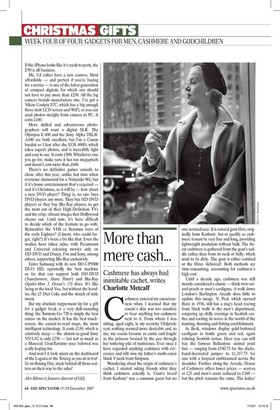More than mere cash...
Cashmere has always had inimitable cachet, writes Charlotte Metcalf Cashmere entered my consciousness when I learned that my cousin's skin was too sensitive to bear anything but cashmere next to it. From where I was sitting, aged eight, in my scratchy Chilprufe vest, nothing seemed more desirable and, to me, my cousin became as exotic and fragile as the princess bruised by the pea through her tottering pile of mattresses. Ever since I have regarded anything cashmere with reverence and still own my father's moth-eaten black V-neck from Simpson.
Wondering about the origin of cashmere's cachet, I started asking friends what they think cashmere actually is. 'Goat's beard from Kashmir' was a common guess but no one seemed sure. It is natural goat fibre, originally from Kashmir, but to qualify as cashmere it must be very fine and long, providing lightweight insulation without bulk. The finest cashmere is gathered from the goat's saddle rather than from its neck or belly, which tend to be dirty. The goat is either combed or the fibres `dehaired'. Both methods are time-consuming, accounting for cashmere's high cost.
Until a decade ago, cashmere was still mainly considered a classic — think twin-setand-pearls or men's cardigans. A walk down London's Burlington Arcade does little to update this image. N. Peal, which opened there in 1936, still has a stag's head rearing from black walls in the men's department, conjuring up chilly evenings in Scottish castles and rooting its wares in the world of the hunting, shooting and fishing establishment.
In Berk, windows display gold-buttoned cardigans in bottle green and red, again echoing Scottish tartan. Here you can still buy the famous Ballantyne animal print line — ranging from £540.75 for the dachshund-decorated jumper to £1,357.75 for one with a leopard emblazoned across the shoulder. Further along the Arcade, House of Cashmere offers lower prices — scarves at £25 and men's coats reduced to £360 — but the pitch remains the same. The ladies' stoles are in piles of tasteful autumnal hues while the men's windows show navy matched with red. These shops are where you browse for your parents in the certainty that you are buying timeless quality.
Cashmere might have retained its staid — if elegant and impeccable — image had not three things happened that transformed our perspective. First Brora opened a shop in Chelsea, aiming to capture a younger market. Second, a spate of mail-order companies like Pure and Cashu sprang up, selling many colours at affordable prices. Then Pringle of Scotland, founded in 1815, appointed Clare Wright Keller, previously of Gucci and Ralph Lauren, as creative director. She gave us the chunky knits that wowed celebrities like Madonna and Nicole Kidman and inspired a whole new look.
Before Brora, my only cashmere purchase was a beautiful but cripplingly expensive cardigan from TSE. TSE was founded in 1989 on the premise that cashmere had been greatly underused and was perceived to be reserved for the elite. TSE claims that its 'modern adaptation of the traditional commodity forever changed the luxury cashmere business'. Certainly TSE paved the way but it was not until Brora arrived that the real revolution began.
Brora claims it is the 'marriage of nostalgia and modernity of design' that separates it from its competitors, but in truth this is affordable cashmere in young shapes — gauzy boleros, ballet wraps, cropped cardigans, skinny ribs — not to mention the myriad of soft-hued colours.
With cashmere firmly planted in the national psyche, enter Tesco. In Tesco's Christmas television commercial, starring the Spice Girls, a red cashmere cowl neck is featured and Baby Spice has put in her own order for the joggers and hooded top (£50 and £40 respectively) that are flying off the shelves. Tesco's cashmere is fashionable, affordable — and machine-washable. When I ask how, the technical department tells me this information is not in the pubic domain for their competitors to see.
The democratisation of cashmere has truly begun and, with the surge in sales, has arrived a plague of moths. According to the man from Rentokil who sprayed our house, 'The moths love the stuff and everyone's got a cashmere something now, haven't they?'
OK, so everyone's 'got a cashmere something now' but who cares? Its ubiquity has done little to diminish cashmere's reputation as the caviar of clothing. A pair of socks, so long as they are pure cashmere, is still a more than acceptable gift. Anyone who has ever put on a pair and luxuriated in that toasty warmth will know why. It's simply the best, moth-eaten or not.


































































































 Previous page
Previous page